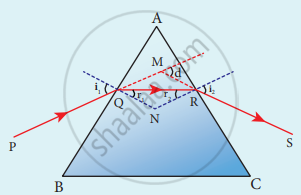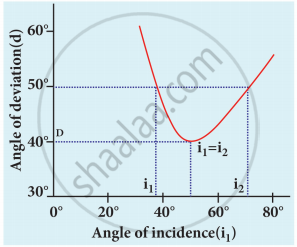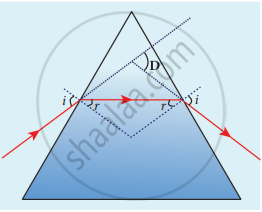Advertisements
Advertisements
प्रश्न
Derive the equation for an angle of deviation produced by a prism and thus obtain the equation for the refractive index of the material of the prism.
उत्तर
- The angle between the direction of the incident ray PQ and the emergent ray RS is called the angle of deviation d.
- The deviation d1 at the surface AB is,
angle ∠RQM = d1 = i1 – r1 - The deviation d2 at the surface AC is, angle ∠QRM = d2 = i2 – r2

- Total angle of deviation d produced is
d = d1 + d2
Substituting for d1 and d2,
d = (i1 – r1) + (i2 – r2)
After rearranging, - d = (i1 + i2) – (r1 + r2)
In the quadrilateral AQNR, two of the angles (at the vertices Q and R) are right angles. Therefore, the sum of the other angles of the quadrilateral is 180°. - ∠A + ∠QNR = 180°
From the triangle ∆ QNR,
r1 + r2 + ∠QNR = 180°
Comparing these two equations and we get,
r1 + r2 = A
substituting in equation for angle of deviation,
d = i1 + i2 – A
- A graph plotted between the angle of incidence and angle of deviation.
- The minimum value of angle of deviation is called the angle of minimum deviation D. At minimum deviation,
- the angle of incidence is equal to the angle of emergence, i1 = i2
- the angle of refraction at face one and face two are equal, r1 = r2

- the incident ray and emergent ray are symmetrical with respect to the prism.
- the refracted ray inside the prism is parallel to its base of the prism.
The case of the angle of minimum deviation is shown in figure.
-
Refractive index of the material of the prism
At minimum deviation, i1 = i2 = i and r1 = r2 = r
D = i1 + i2 – A = 2i – A (or)
i = `("A + D")/2`
r1 + r2 = A ⇒ 2r = A (or)
r = `"A"/2`
n = `(sin "i")/(sin "r")`n = `(sin (("A + D")/2))/(sin ("A"/2))`
APPEARS IN
संबंधित प्रश्न
What is prism?
Why do we see white color in Newton’s disc, when we rotate it very fast?
What is Rayleigh’s scattering?
Why does sky appear blue?
What is the reason for reddish appearance of sky during sunset and sunrise?
Which of the following is not a prism?
Rectangular prism is also called a ______.
Name the triangular piece of glass that splits white light into different colours.
Why danger lights in vehicles are red in colour?
How does the angle of minimum deviation produced by a prism change with increase in
- the wavelength of incident light, and
- the refracting angle of prism?
